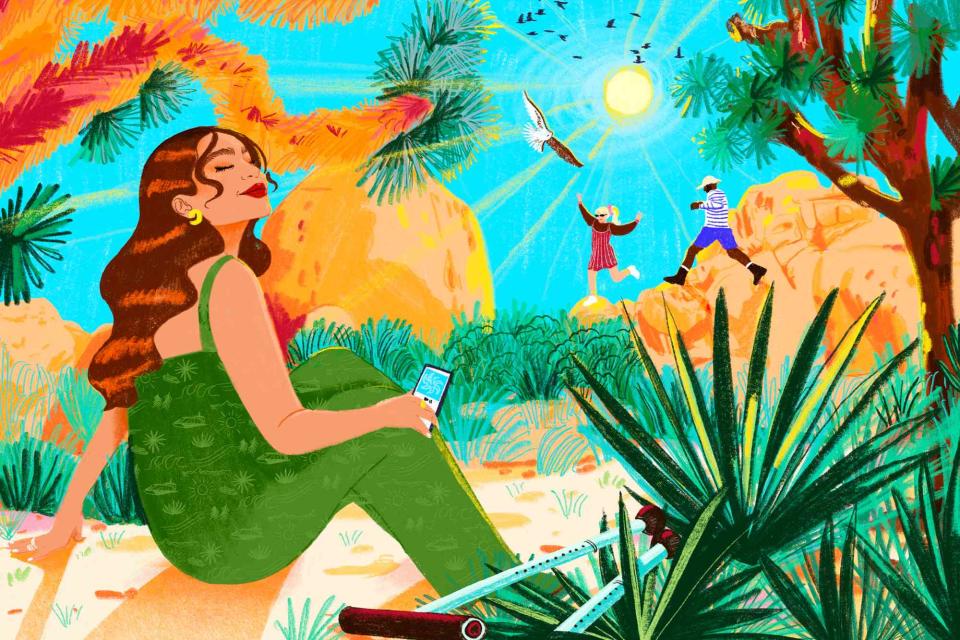How I Explore America's National Parks As a Disabled Traveler
By accepting my body for what it cannot do, I focus on what it can.

ILLUSTRATION BY KATIE SMITH
Several summers back, I set out for the desert. I grew up in Los Angeles, so Palm Springs was a familiar oasis, but nearby Joshua Tree National Park remained a mystery. A few friends asked if I wanted to join them there on a quiet weekday in July, and as I drove out, I felt that specific rush that comes from forging a new path — especially one as literal as a dirt road off a main highway.
Like the journey along that road, traveling in my disabled body has always had its fair share of bumps. I was born with cerebral palsy, as well as an insatiable need to go and see and do. As a preteen, I remember telling my mom I wanted to visit Antarctica around the same time I spent two months on bed rest, watching closely as the surgical scars on my legs faded from red to pink. And while my family has yet to complete that particular trip, we often take to the open road, occasionally stopping at national parks along the way.
"I long ago gave up on the mindset that to truly immerse myself in the outdoors, I must experience it as I’ve been told I should. I may not be able to hike alongside a river, but I can cross it by boat. I wouldn’t dare ski down a slope, but I can ascend one by gondola."
We’ve stood at the edge of the Grand Canyon at sunset, and we’ve gazed up at soaring redwoods and sequoias shrouded in mist. We’ve cut through the heavy, humid atmosphere of the Everglades on airboats and glided past the glaciers of Alaska on a cruise ship. Ahead of every excursion, I’ve had to plan each step carefully. Since the muscles in my legs constrict with too little or too much movement, I can only walk unaided for about a half-hour. That means I must condense the wide wilderness into the short range of my scissoring gait.
I’ll tell you a secret about having a disability, one that most people only learn when they’re old: your body is never in your complete control. It’s yours to manage and to oversee. Of course, it’s your ears that listen to a cascading waterfall and your eyes that glimpse birds flying from tree to tree. It’s your legs that lunge and stride and carry. But sometimes my knees won’t bend low enough to allow my hands to touch crystal-clear water. Usually, my hips won’t have the flexibility to reach the next landmark on foot. And more often than not, I lack the balance to stand on uneven paths, so I must stick to smooth pavement.
My disability isn’t something to be sad about, and I don’t create space to pity it. I long ago gave up on the mindset that to truly immerse myself in the outdoors, I must experience it as I’ve been told I should. I may not be able to hike alongside a river, but I can cross it by boat. I wouldn’t dare ski down a slope, but I can ascend one by gondola. And when I met my friends in Joshua Tree, I listened to Fleetwood Mac from my phone’s tiny speaker and watched them leap from one egg-shaped boulder to the next, relishing in their excitement from my comfortable spot in the shade. Later, we all took in the park’s namesake trees, their jagged branches almost seeming to greet us.
By accepting the limits of my body, I can explore at a pace that best suits it. This is a freedom of its own, one that allows me to find satisfaction wherever I stand, and I lean on it most in the wild. After all, no one tells a mountain to be taller or a wildflower to be more fragrant. Instead, we value nature for what it is and take in all of the grace and beauty it has to share. The same can be true for our bodies — especially those not traditionally found on the trails.
Kelly Dawson is a writer, editor, and media consultant based in Los Angeles. Follow her on Instagram @kellydawsonwrites.
A version of this story first appeared in the July 2023 issue of Travel + Leisure under the headline "Go Your Own Way."
For more Travel & Leisure news, make sure to sign up for our newsletter!
Read the original article on Travel & Leisure.


